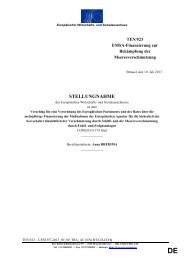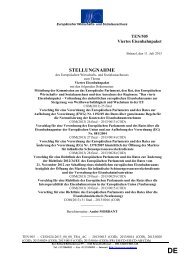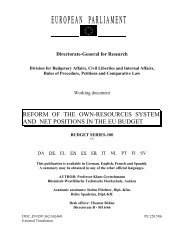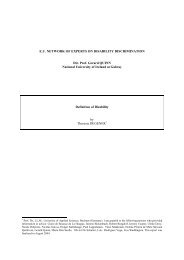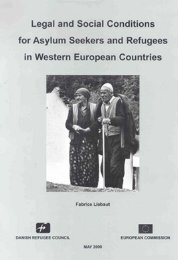Bulgaria - The social impact of seasonal migration
Bulgaria - The social impact of seasonal migration
Bulgaria - The social impact of seasonal migration
You also want an ePaper? Increase the reach of your titles
YUMPU automatically turns print PDFs into web optimized ePapers that Google loves.
10<br />
1. Historical Overview - Migrations After WWII<br />
1.1. In-<strong>migration</strong>, 1944-1989.<br />
a) Until the end <strong>of</strong> WWII, the changing political boundaries <strong>of</strong> <strong>Bulgaria</strong> were the basic<br />
factor explaining <strong>migration</strong>, especially in the border regions (Bobeva 1994, 221). After<br />
September 1944, as a defeated Axis-country, <strong>Bulgaria</strong> had to return the lands it acquired<br />
in April 1941 as a German ally, i.e. Aegean Thrace, Aegean and Vardar Macedonia, as<br />
well as the border regions around Tsaribrod and Bosilegrad, which it disputed with<br />
Yugoslavia. After these territories went to Greece and Yugoslavia at the end <strong>of</strong> WWII,<br />
thousands <strong>of</strong> ethnic <strong>Bulgaria</strong>ns left for <strong>Bulgaria</strong> proper and were resettled there roughly<br />
until 1949. Until the end <strong>of</strong> 1944 only, around 100 000 <strong>Bulgaria</strong>n immigrants were<br />
welcomed into the country (Vassileva 1991, 138-53). 1 <strong>The</strong>se <strong>migration</strong> waves included<br />
two types <strong>of</strong> <strong>Bulgaria</strong>n migrants - refugees, namely people from <strong>Bulgaria</strong>n origin but <strong>of</strong><br />
foreign citizenship who were leaving their home places in Alexandroupolis, Xanti,<br />
Drama, Kavala, Demirhisar, Siar, Tasos island, etc. for the first time; and the so called<br />
resettlers, i.e. <strong>Bulgaria</strong>n citizens who migrated from <strong>Bulgaria</strong> proper to the newly<br />
incorporated lands in 1941-3 and were now to return to their pre-war settlements. <strong>The</strong><br />
refugees went primarily to the South-western <strong>Bulgaria</strong>n regions <strong>of</strong> Gorna Dzhumaia,<br />
Plovdiv and S<strong>of</strong>ia, while the resettlers (from Aegean Thrace) went back to their former<br />
dwellings in Stara Zagora and Bourgas regions in the <strong>Bulgaria</strong>n South-east.<br />
Once in <strong>Bulgaria</strong>, the newly arrived <strong>Bulgaria</strong>n immigrants experienced two further<br />
types <strong>of</strong> movement in the second half <strong>of</strong> the 1940s. Those <strong>of</strong> them who were from Vardar<br />
and Aegean Macedonia were transferred - voluntarily and sometimes involuntarily - to<br />
Yugoslavia, into the then People's Republic <strong>of</strong> Macedonia. In 1945, Yugoslavia attempted<br />
to gather all <strong>of</strong> them on the territory <strong>of</strong> the People's Republic <strong>of</strong> Macedonia, and was<br />
assisted in its efforts by the <strong>Bulgaria</strong>n government, which then propagated the<br />
establishment <strong>of</strong> a Balkan Federation and believed in the existence <strong>of</strong> a separate<br />
Macedonian nation. Although the exact number <strong>of</strong> people transferred from <strong>Bulgaria</strong> to<br />
Yugoslavia is not known, some researchers think it is around 40 000.<br />
<strong>The</strong> second type <strong>of</strong> movement experienced by the newly arrived <strong>Bulgaria</strong>n immigrants<br />
was their resettlement throughout <strong>Bulgaria</strong>. In 1945, the number <strong>of</strong> <strong>Bulgaria</strong>n refugees<br />
settled to <strong>Bulgaria</strong> was 12 015, and that <strong>of</strong> resettlers - 22 444. During the secondary<br />
resettlement, <strong>Bulgaria</strong>n immigrants from South-western <strong>Bulgaria</strong> were sent to Northern<br />
and North-eastern <strong>Bulgaria</strong>, as well as Dobrudzha in order to alleviate the <strong>migration</strong><br />
pressure on the South-western areas and find better opportunities for work and survival<br />
<strong>of</strong> the migrants. <strong>The</strong> majority <strong>of</strong> them settled in villages. <strong>The</strong>y were primarily small<br />
peasants, who rarely possessed more than 50 dka <strong>of</strong> arable land. <strong>The</strong> secondary<br />
resettlement ended in 1949, and a change in the law <strong>of</strong> <strong>Bulgaria</strong>n citizenship adopted in<br />
1950 gave <strong>Bulgaria</strong>n citizenship to all refugees <strong>of</strong> <strong>Bulgaria</strong>n origin but without<br />
citizenship.<br />
b) Two other waves <strong>of</strong> in-<strong>migration</strong> - this time for political reasons - took shape in the<br />
late 1940s. Greek Communists and civil war fighters began migrating to <strong>Bulgaria</strong> after<br />
1 For <strong>migration</strong> trends in the period before WWII, see the collection <strong>of</strong> documents Migratsionni dvizheniia<br />
na bulgarite: 1993




